 |
 |
|
 |
 Calabash master Gong Yi-Fang Calabash master Gong Yi-Fang
Mr. Gong Yi-Fang came from Linyuan’s Gongcuo Village of Kaohsiung County (he currently resides in Fongshan). He began learning sketching, knot art and sculpturing since he was young, and has been in the calabash art industry for over a decade. His works can be roughly categorized int calabash painting; pyrography; colored carving; plain carving; green-retaining carving; embossing; calabash lamps; cut and assemble techniques; calabash devices; golden foil and inlaying etc.!
Mr. Gong was also the earliest to research of Chinese knot art in Taiwan; he began to learn about gourd art nine years ago, and introduced it into Taiwan, in addition to the creation of the carving technique based on the five methods of inks (in order to exhibit the layers for the patterns and the embossments). The exquisite calabashes are given a brand new art life under Mr. Gong’s meticulous cultivation and carving. It is not only scarce in the market, but is also known as the artwork of utmost uniqueness. He also participated in the traditional art exhibitions in the United States several times on behalf of Taiwan, and promoted calabash art to the international platform. |
 |
 Introduction to calabash art Introduction to calabash art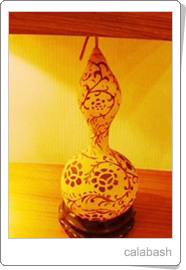
Gourd art is also known as calabash art, as calabash was originally named as gourd. Although it is not one of those expensive vegetables, calabash has been inseparable from people’s lives since ancient times. From the perspectives of eating, using and painting calabashes, it is evident that they are not merely delicious cuisine, but also act as an alternate product for bowls, ladles and pots in daily life; and with ingenuity and finishing process, they can even become exquisite decorative arts. As compared to other melon and fruits, its most distinguishing characteristic is that the peel will lignify after dehydration to form the best natural wooden objects; a bowl can be formed when the bottom half is cut away; two ladles can be created by cutting it in the middle; where as maintaining the original form will offer as natural bottle or pot. With such broad applications, one might as well call them calabash devices.
Besides from the device with broad applications, calabash also implies various lucky meanings; it is also the most common theme for traditional folk arts, the reason is that葫蘆(calabash, pronounced as Hulu in Chinese) and 福祿(happiness and prosperity, pronounced as Fulu in Chinese) has very similar pronunciations, thus calabashes became the mascot for bringing happiness. Furthermore, calabash belongs to melon vines, thus they usually ramble with abundant fruits, which also represents the implication of the concept of propagation and inheritance, therefore it also has the meaning of praying for more descendents. Other than this, calabash can be used as bottled containers, often implied as medicine or alcohol bottle with unbelievable black arts, thus calabashes are the vital accessory and talisman for doctors, recluses or immortals in fairytales and folk legends. |
 |
|
 Origin of gourd art techniques Origin of gourd art techniques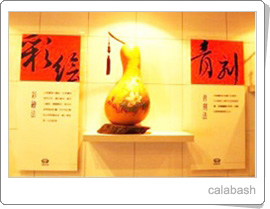
Gourd arts began to appear since the craft art history of the Ming dynasty; in fact, the earliest can even trace back to the Tang dynasty. The emphasis of calabash art is not on altering its original form, but rather to utilize carving or painting techniques to decorate the peel, and give calabash a brand new appearance. Besides enhancing the aesthetic value, it can also become a decorative art piece. Special processing must be taken care of prior to the decoration of calabash; for instance, when harvested from the field, a hole would be drilled in the stem to remove the fruit flesh and seeds; then the exterior green layer would be shucked in order to bleach and dry the entire empty calabash; after lignification, the hard calabash bottle will be completed with exquisite quality.
After processing, one can get on with the decorative working such as carving or painting; since the thickness for calabash is extremely thin, the technique of high relief cannot be applied; thus the most common carving technique application is the delicate intaglio carving; in other words, the main pattern is preserved with the background being carved out a very thin layer to allow the surface of calabash with variation of layers.
Painting decoration is the most common form; with the exquisite painting job by the artists, a layer of varnish or shellac is applied to transform into the bright and colorful calabash. The painting techniques for calabash is actually testing the artist’s calligraphy and painting skills, thus painted calabash is not merely a handiwork, but also a painted art piece that’s worth the relish.
|
 |
 Presentation of Taiwanese gourd art Presentation of Taiwanese gourd art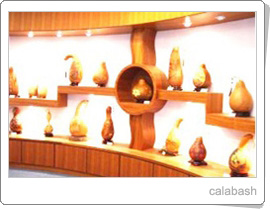
Gong Yi-Fang from Fongshan of Kaohsiung County is currently the one who promotes gourd art the most in Taiwan. He began over a decade ago to devote in research and creation; on the one hand, to enhance the traditional techniques of folk gourd arts; on the other hand, seeking for the new market for gourd art. Gong Yi-Fang’s gourd art works has the courage to breakthrough the limitations of traditional gourd art; therefore besides the intaglio carving and painting, he introduced new decorative techniques, including pierced carving, lamination and inlay, which completely altered the appearance of traditional calabash art. In order to exhibit innovation through the alteration of calabash forms, the improvement of the breed has been undertaken directly, where he cultivated various gourds by himself, with the selection of varying forms during the cultivating progress as the material for creation. Furthermore, Gong Yi-Fang’s artwork themes are enriched with religion, such as Buddha, Guanyin, Kṣitigarbha, Tianwang and Fentian etc.; with the application of commonly used shellac to exhibit the simple, unsophisticated and elegant religious artworks. |
 |
 Gourd Sculpture Museum Gourd Sculpture Museum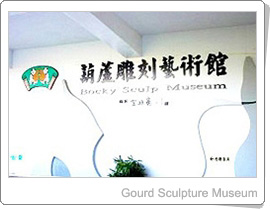
Address: No.5, Ln. 45, Sihma Rd., Shanlin Township, Kaohsiung County 846, Taiwan (R.O.C.)
Telephone:886-7-69771755
The Gourd Sculpture Museum located in Sinjhuang Primary School was established in the 87th Taiwanese year (1998); each calabash in the museum is exquisitely decorated and sculptured artwork with various stylish patterns, including Chinese style, Geomantic omen style, Religious style…etc.; some of these calabashes exhibited are in brand new “form” after the “anaplasty”, and Mr. Gong Yi-Fang is the one who has been promoting to give the calabashes a new life. Gong Yi-Fang is known as the creator for Taiwanese gourd art; he incidentally got in contact with calabash sculptural art from Mainland China when he went to Hong Kong over a decade ago, and has been indulged in the art world of calabash ever since. In the 85th Taiwanese year (1996), Mr. Gong was invited by the principal of Sinjhuang Primary School, to teach the students, teachers and the community people about calabash sculpture during the nights, so as to inherit the calabash art. The Gourd Sculpture Museum was formally open to the public during the 88th Taiwanese year (1999) for more people to learn about the beauty of calabash sculptural art.
With many years of inheritance and development, there are several sculpturing techniques for calabashes at the present, including painting, green-retaining carving, embossing, plain carving, pyrography, resin clay sculpturing, tying technique to alter the forms, cut and assemble technique etc., which are different from one another; for instance, painting offers vividness; plain carving provides simplicity; where as pyrography turns the shortcomings of calabashes into art. The painting technique can be attempted by anyone regardless of their ages and art skills, where they can try to give calabashes a make-over as long as they have the paints and tools in hand.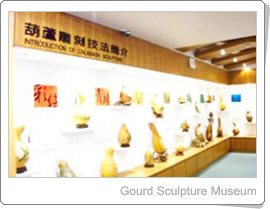
With the cultivation during the recent years, calabash art has become one of the distinguishable characteristics for Shanlin Township; moreover, it is heading towards the goal of turning Shanlin Township into the first calabash village in Taiwan. When you have the opportunity to pay a visit to this small town, don’t forget to take a look at the calabash art.
This article was published in “Taiwan Traditional Arts”, Taipei: Tunghua Bookstore in January, 1997 Please inform us if there is any copyright infringement |
|
|
 |
 |
 |
|
|
|
|
|